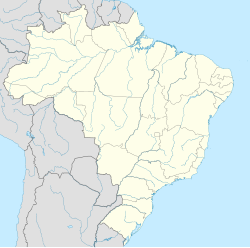Guapimirim (Portuguese pronunciation: [ɡwɐpimiˈɾĩ], from Tupi 'little spring', guapi 'spring', mirim 'little'), is municipality in the Brazilian state of Rio de Janeiro around 50 km(31 miles) from its state capital, the city of Rio de Janeiro. Its in a region known as Baixada Fluminense and the Greater Rio de Janeiro metropolitan area.
Guapimirim | |
|---|---|
Municipality | |
| Município de Guapimirim | |
 Dedo de Deus Mountain | |
 Location of Guapimirim in the state of Rio de Janeiro | |
| Coordinates: 22°32′13″S 42°48′55″W / 22.53694°S 42.81528°W | |
| Country | |
| Region | Southeast |
| State | |
| Government | |
| • Prefeito | Zelito Tringuelê (PDT) |
| Area | |
| • Total | 356.566 km2 (137.671 sq mi) |
| Elevation | 48 m (157 ft) |
| Population (2020 [1]) | |
| • Total | 61,388 |
| Time zone | UTC−3 (BRT) |
| Website | [1] |
The municipality is in the Serra dos Órgãos mountain range where its most famous tourist attraction, the Dedo de Deus, is located. 70% of its area is under environmental protection, most notably the Serra dos Órgãos National Park.
Geography
editThe population of Guapimirim was 61,388 in 2020, and its area is 361 square kilometres (139 sq mi).[2]
Conservation
editThe municipality contains part of the Central Rio de Janeiro Atlantic Forest Mosaic, created in 2006.[3] It held 24% of the 4,920-hectare (12,200-acre) Paraíso Ecological Station, created in 1987 and now integrated into the Três Picos State Park.[4] It contains 4% of the 46,350-hectare (114,500-acre) Três Picos State Park, created in 2002.[5] It contains part of the 19,508-hectare (48,210-acre) Bacia do Rio Macacu Environmental Protection Area, created in 2002.[6] The municipality contains the 15,582-hectare (38,500-acre) Guapi-Guapiaçú Environmental Protection Area, created in 2004.[7] It contains 42% of the 1,936-hectare (4,780-acre) Guanabara Ecological Station, created in 2006.[8]
References
edit- ^ IBGE 2020
- ^ IBGE - "Archived copy". Archived from the original on 2008-06-11. Retrieved 2007-02-20.
{{cite web}}: CS1 maint: archived copy as title (link) - ^ Costa, Cláudia; Lamas, Ivana; Fernandes, Rosan (December 2010), Planejamento Estratégico do Mosaico Central Fluminense (PDF) (in Portuguese), Reserva da Biosfera da Mata Atlântica, p. 13, archived from the original (PDF) on 2016-10-07, retrieved 2016-10-02
- ^ ESEC do Paraíso (in Portuguese), ISA: Instituto Socioambiental, retrieved 2016-10-03
- ^ PES dos Três Picos (in Portuguese), ISA: Instituto Socioambiental, retrieved 2016-10-03
- ^ APA da Bacia do Rio Macacu (in Portuguese), INEA: Instituto estadual do ambiente, archived from the original on 2016-10-10, retrieved 2016-10-07
- ^ *Pedreira, Bernadete da Conceição C.G.; Cardoso Fidalgo, Elaine Cristina; Camardelli Uzeda, Mariella; Alves da Costa, Michell Douglas (December 2011), "Áreas Prioritárias para Recuperação na Região da Bacia Hidrográfica do Rio Guapi-Macacu, RJ" (PDF), Boletim de Pesquisa e Desenvolvimento (in Portuguese), ISSN 1678-0892, retrieved 2016-10-10
- ^ ESEC da Guanabara (in Portuguese), ISA: Instituto Socioambiental, retrieved 2016-10-05


